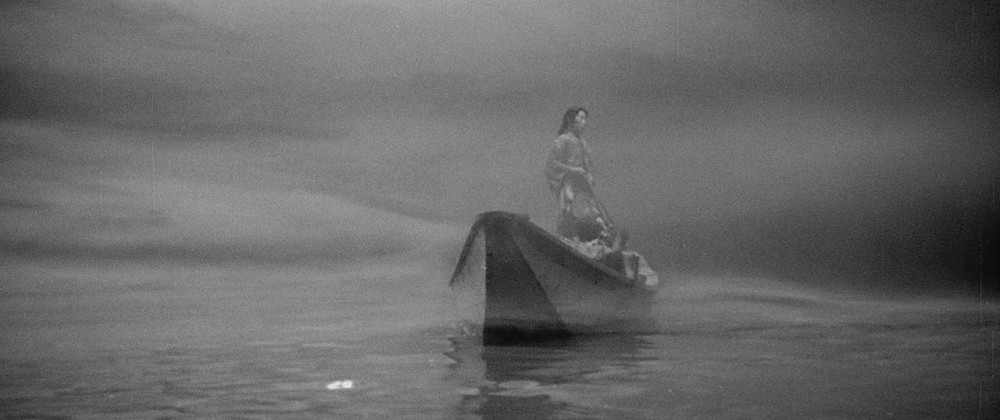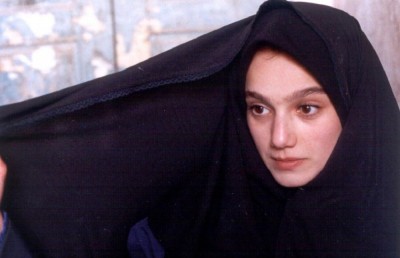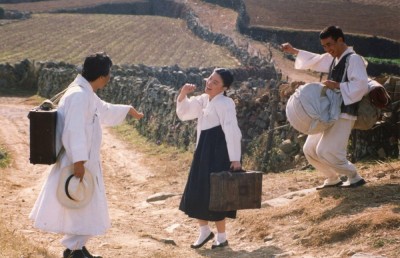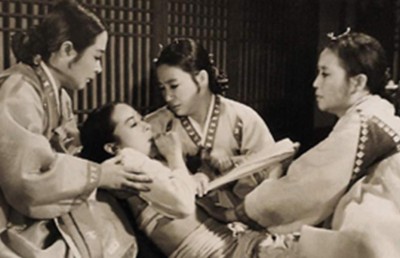Kenji Mizoguchi, The Master
Cinematheque Ontario's Mizoguchi Retrospective

In 1996 James Quandt, programmer for the Cinematheque Ontario in collaboration with the Audio-Visual Division of the Japan Foundation,Tokyo organized the film series, “Mizoguchi The Master.” The series included stops along New York, Edmonton, Vancouver, Los Angeles, Chicago, Cleveland, Rochester, Washingont D.C, Atlanta and Toronto. My teaching schedule prohibited me from leaving the city for more than a few days so I planned judiciously and drove to Toronto the Sunday when four rare Mizoguchi films were programmed. Seeing these four rare Mizoguchi films in one sitting was not only a real treat but an invaluable addition to an understanding of his films within an historical contextualistion. The films were screened out of chronological order, beginning with Musashi Miyamoto followed by The Famous Sword, Osen and Hometown.
As it turned out the first film was the best. Both wartime films were designated as propaganda films, but Musashi relies so pervasively on natural landscapes and man’s humble place within it that any pro-military elements are overwhelmed by nature’s peaceful presence. In the opening scenes this aesthetic, which shapes much of Sansho the Bailiff, is quickly established. Whether static or moving (lateral tracking shots following characters through the woods), the camera composes the players within the forest’s foliage, huge mountains and calming waters; even the soundscape (rushing water, the sound of cuckoo birds) envelopes the viewer in a naturalized mind space. The narrative plays on primal feelings of hate and vengeance. A young boy and girl are fiercely committed to avenging their father’s murder and approach a master samurai for training. The samurai, Musashi, instructs them that martial arts are not at the service of vengeance, but he reluctantly consents to training them. Training sequences are filmed – as is much of the film – in natural splendor. One particular space, with a mountain and water visible in the foreground, appears several times as a site of tranquility and harmony. The men who killed the father, Sasaki and the Samato brothers, ambush the boy and girl, leaving the girl alive as an informant to Musashi, with the belief that an angered Musashi will be an easier opponent. In a lovely scene Mizoguchi crosscuts from the girl outside the master’s porch, with master visible in background, to Musashi inside sculpting a Buddha (as he later says, “the essential spirit in fencing is also in the fine arts”). The master, angered when he is told about the boy’s death, must now test himself against his own teachings. The story flashes ahead one year, with Musashi finally tracking down Sasaki. He challenges Sasaki to a duel not out of vengeance but as a test of skill (or so he says anyway). As a partial gesture to military conduct and Japanese traditional art, the fight sequences are staged in a formal, theatrical manner, with highly mannered movements and gestures. A fight is arranged on a nearby island. The Samato brothers try to ambush Musashi as he exits his home but Musashi easily unarms and cripples them in quick order. Likewise, the anticipated showdown lasts barely one round as Musashi fells his opponent with one quick blow, then runs away as the camera tracks with him for a short while then stopping to frame the fallen opponent. Mizoguchi does several things here that help to subvert the intended militiarism (propaganda). First, the noted anti-climactic nature of the fight sequences. There is no revelling in victory or in its power. When Musasjhi arrives on the island for the duel his arrival is captured with shots that “pillow” him in nature: an overhead shot of the water splashing on the shore; a huge tree dominating the foreground space. After vengeance has been served, the sister shows no gloading signs of victory or happiness. Instead she humbly tells Musashi that she will join an order to pray for her brother and father’s soul. Musashi responds by telling her “I admire your strength… and will think of you as my wife.” Mizoguchi then cuts to a shot of water hitting the rocks before cutting back to a CU of Musashi walking toward the camera framed at a slight low angle. This ending decidedly downplays notions of heroism that would serve a nation at war.
The next film, The Famous Sword, is less successful in subverting its propaganda intent. Appropriately, most of this film was filmed in a studio, robbing Mizoguchi of the natural imagery which was so vital in nullifying the militarism of Musashi. The Famous Sword tells the story of a swordsmith, Kiyone, whose latest sword fails during a battle, causing shame and punishment to its owner. Kiyone attempts seppuka (suicide) but is stopped by Sasae, the daughter of the chastised swordsman. Having failed at suicide Kiyone’s only means of redemption is to build a perfect sword. In a narrative twist which reminds me strongly of Andrei Tarkovsky’s Andrei Rublev (the disillusioned painter), Kiyone loses his will to build after Mr. Onoda (the man who he failed earlier) is murdered by a disgruntled suitor. In the following scene the studio staginess is most evident. The dejected Kiyone is slumped on a tree stump with artificial sky and stars filling the background. Kiyone regains his will to build when Sasae pleads with him to make her a sword to avenge her father’s murder. This personal motif is not at the service of country, so the narrative fills in the gap when Kiyone’s duty expands to making swords for the Emperor (In a letter to Sasae he writes, “I hope I’ll be able to work for our country”). Kiyone begins melding, banging and casting for the perfect sword in a series of sequences which, again, recall Rublev (the bell casting scene). Mizoguchi makes literal what is created poetically in later films ( Ugetsu for ex.) with superimpositions of Sasae’s spirit helping Kiyone cast the sword. (in one nice touch the sound of three clanging hammers including Sasae’s spills over into the next shot of human characters). In a final battle the Naito clan (the man who killed Sasae’s father) raid the Royal court. In a long [60 seconds] left to right scroll shot Sasae kills Naito with the help of Kiyone and his helper. The fight has the same formalized, ritualistic feel as in Musashi (the camera movement and fighters are locked in a rhythmic stop/go flow) but in this case the vengeance is felt as the guiding force, rather than skill and art of battle. Unlike Musashi, the film concludes happily, with Sasae and Kiyone drifting together down a mist-enshrouded lake as bomb-like sounds resonate on the soundtrack.
The Mizoguchian element one most remembers in this film is the self-devotion of the woman, Sasae, as she stops Kiyone from killing himself and then rekindles his will to create. Also, this film has more humor than most Mizoguchi films, not all of which works. The opening sequence of the father and daughter fencing is played for comedy with the daughter taking advantage of the father’s momentary lapses in defence. The nicest comic moment comes when Sasae gently taps Kiyone on the forehead with a bamboo stick after he asks her if she has amorous intentions for another man. The gag is funny because Sasae surprises us by getting the stick from below the frame; and secondly, the tap speaks volumes for the social mores and the position of women in Japanese society.
The Downfall of Osen, a favorite of theorist Noel Burch ( To the Distant Observer ), can be likened to shards of a kalaidescopic mirror. It has a complex narrative structure which includes three time frames (present and two pasts), attention grapping camera movements, Murnauian art design and compositions and a voice-over recorded by benshi Suisei Matsui which takes some getting adjusting to (and perhaps gives some credence to Burch’s belief that the benshi functions as a distanciating effect). The opening at a train station is as gothic as Mizoguchi has ever been. One shot begins on leaves and quickly tilts up to a man. Shots at the train station are intercut with studio minatures of trees and houses; wind howls on the soundtrack. One could almost mistake this for the beginning of a Universal horror film! The type and quality of camera movements range from a prototype steadicam shot literally chasing a woman up stairs to other jerky, less effective movements. Some are clearly motivated by narrative or character movements, others are not. In the flashback we see the man from the train station, Sokichi, as a young boy who is saved from death by Osen and then supported by Osen through medical school. In a shot which may be autobiographical (before becoming an established director Mizoguchi was supported by his sister), Sokuchi studies by candlelight as Osen sits up with him. Osen resorts to prostitution to support Sokichi’s schooling. She is wrongfully arrested and loses contact with Sokuchi. Osen blows an Origami into the air -a symbol for his soul? The same origami brings us back to the present at the train station. Sokuchi the doctor brings the sick Osen to a hospital, but she can not recognize him and yells “all men are beasts.” The camera tracks along the ground following leaves before finally cutting back to a shot of Osen sitting on the hospital bed, a look of despair on her face. Again we have the typical Mizuguchi heroine and the (Tarkovskian) theme of self-sacrifice. Osen can only regain her soul through Sokuchi but seems to have lost it before being able to realize the success of her earlier sacrifice.
The final film, Hometown (1930), was Mizoguchi’s first sound film. This alone increased the film’s interest because sound became a staple in Japan only by the mid-thirties. If it was possible in 1930 why did it take so long for sound to become standard? Were the benshi’s such a powerful labor force? Was it just a matter of a slower dispersion of the technology? This question is valid because Hometown, while clumsy at times, demonstrates that Mizoguchi had good spatial- acoustic ideas and it is apparent that it wouldn’t have taken Mizoguchi another 4 or 5 years to master sound. The story is about a tenor, Yoshie Fujiwara (playing himself), who struggles to achieve fame, and then comes to realize that humility and art take precedence over fame (a very “Japanese” theme). Along the way he is supported by a woman, Ayako, who helps him become a star and then becomes alienated and replaced by a selfish groupie. Interestingly, the Mizoguchian thematic of female self-sacrifice is already present in 1930. However, what makes this film really interesting is how Mizoguchi experiments with every Western device: tracking, dolly shots, tilts, montage sequences, close-ups (which he would soon abandon); while skirting with formal devices he would develop later: such as a semi-scroll shot in a record store. There is a tendency to also shoot in long takes, but these are interrupted by intertitles.
Like early American silent films, Hometown has a schizophrenic style: static for the song numbers and fluid and unbound when shooting silent. For example, Fujiwara’s song sequences are shot with a static camera in long shot, while a sequence of them listening to the radio is filmed with a jerky camera (the undercranking magnifying the camera glitches) which tracks from Fujiwara to other patrons in the cafe. The film opens with left to right tracking shots from a boat, with cuts on movement to spectator point of view shots. A group of young women (flapppers, or Moga as they were known in Japan) are waiting to greet, Misao Sato, a famous tenor who studied in Italy. Fujiwara (who actually doesn’t look very Japanese and must have had a caucasian parent) soon overtakes Sato in popularity. Fujiwara begins to let the fame go to his head, which worries Ayako because she feels he is squandering his talents. In an effort to “reel” him in Ayako feigns love with another man to get Fujiwara jealous. Mizoguchi achieves this with a clever peephole POV shot of Fujiwara looking at Ayako and her new lover. Fujiwara then leaves with another woman after seeing this, and his emotions carry over into a wild party sequence with paper streamers cluttering the frame, unnatural high angle shots, and kinetic camera movements. Knowing Mizoguchi’s admiration for Sternberg there is little doubt that this sequence was influenced by the ball sequence in Underworld (1927) . Ayako makes her motives known to Fujiwara in a letter which urges him to consider “art over fad.” A car crash puts his singing in jeopardy and provides Fujiwara with the time to contemplate his career (The hospital scene provides an unintentionally funny shot of Fujiwara lying on the bed with a towel and ice pack strapped around his head!). Prudence wins out and Fujiwara opts for “serious” music. The film concludes with Fujiwara singing two classical songs in a huge ampitheatre with friends looking on approvingly from offstage. In many ways Hometown is (or could have been) a Japanese The Jazz Singer . It has a similar early silent/sound hybrid style. It has characters who are torn between similar career conflicts. In The Jazz Singer Al Jolson must decide between being a jazz singer or a cantor. In Hometown the conflict is between art and the fame associated with popular music. In both cases the effects of the choices are felt on the people surrounding the singer (wife, friends, mother, father, lover). The way the conflict is resolved reflects greatly on cultural differences. In The Jazz Singer Jolson makes the decision himself, expressing forthright individualism; in Hometown Fujiwara is more of a puppet shaped by the feelings and expressions of people around him (mostly Ayako’s). Both films end with the singers performances in front of large crowds and in the offstage presence of friends/family.













